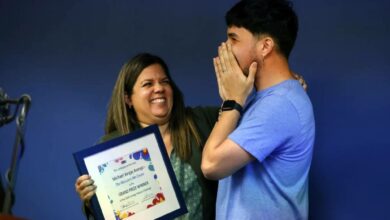High School Math Can Be Playful, Too

To embed exploration into high school math, Sun advocated for an approach that increases cognitive demand. Rote memorization and procedural tasks require low cognitive demand for students, she said during a recent conference session at Learning and The Brain: Teaching Engaged Brains. Approaches like making creative connections, and understanding why something works are explorative ways for students to reach higher cognitive demand in math.
During her conference session, Sun recommended reworking math problems that take a procedural approach like asking students to follow the PEMDAS order of operations, to include more open-ended exploration. For example, math teachers can ask students to create expressions equivalent to integers 0-20 using only three numbers such as 3, 4 and 1 using one mathematical symbol or operation. This allows students to look beyond the memorization of a procedure and apply their own thinking to explore the same basic concepts. For take-home work, having students explore open-ended mathematical concepts through a technology like Desmos or upping the demand of a simpler math task can foster further discussion in class the next day, Sun said.
Finkel said offering students choices – even if small – in how they approach a problem is what makes playful math rigorous. The student who plays “is much more likely to figure out a way to keep the game going,” he said. He also encouraged teachers to get students talking as part of their exploration. Inviting students into the mathematical conversation can take one or two minutes of engaged conversation with students during a class period. One popular teaching strategy that Finkel pointed to is the notice and wonder technique, where teachers ask students to notice and wonder about something that came up during a class lesson.
According to Finkel, when students have ownership over their own math exploration, they question less whether something is mathematically allowed and become more curious about what’s possible. This also makes them more likely to want to include others in their mathematical exploration, said Finkel.
Creativity
Finkel has seen an entire class of students get a problem wrong on a test because of a slight variation in wording that they were not used to seeing. “That to me is the sign of a very fragile understanding,” he said. According to Finkel, math is too big of a subject and too difficult to understand if students are only given memorization tools.
A creative approach to high school math guides students in making sense of mathematical concepts on their own, said Sun. When creativity is brought to students’ explorations in a math classroom, they discover mathematical rules in unconventional ways. Sun pointed to an example from a teacher that she observed during her research. The teacher set up the math problem by stating, “zero percent of 500 is zero, and one hundred percent of 500 is 500.” Then she asked her students to work in groups to find any 10 other percentage points of 500.
From her observation of the percentages classroom exercise, Sun found that the students were able to make up their own rules and successfully found 35 to 40 other percentage points on their own without the use of a plug-in formula. One group discovered, through their creative collaboration, that one percent of 500 was 5. Then as a class they discovered together that if they knew what one percent of 500 was, then they could find all the other percentage points. “There was excitement happening because kids were actually in the groups finding different percentages,” and by the end of the exercise, the students understood that a percent is part of a whole and that there are many ways to find percentages, said Sun.
A play-based approach to high school level math is not just reserved for reinforcing concepts that have already been taught. Play can also be successfully applied at the introductory level of math concepts, Sun said in an interview. Rather than introducing a math concept or activity with vocabulary or formulaic memorization, frontloading with creative exploration gives students the opportunity to “make sense of the math themselves,” she continued.
Collaboration
Teacher modeling followed by independent practice is the norm for high school math instruction, but according to Sun, collaboration among students allows them to reach deeper mathematical understanding.
In upper division high school math classes, Sun suggested incorporating activities like card sorting. These activities not only help students identify patterns, and find solutions creatively, but they allow for students to collaborate to have a greater conceptual understanding of the material. For example, one of Sun’s student teachers recently did a card sorting activity with his pre-calculus students. He asked them to find derivatives of sine and cosine using card sorting, but then asked them a more difficult question: What would the 55th derivative look like?
According to Sun, the students worked in groups, some standing up, and got to work guessing and checking to find possible solutions. Students creatively engaged in the more challenging problem by playing with ideas that they were familiar with, said Sun. This was one question out of ten that the teacher presented to class. The other questions were more traditional in nature, but taking the extra five minutes to incorporate an element of collaborative play in the class went a long way. “I think the understanding was much deeper, and the conversation was much deeper,” said Sun.
Putting it into practice
It can be daunting to introduce play within the bounds of a mathematical teaching system that hasn’t been designed for play. So, Sun suggested that math teachers slowly infuse little moments of play into their class periods. Sun has seen that 10 to 15 minute bursts of play are more manageable than overhauling an entire 55- or 90-minute class period. When it comes to math homework, Finkel said that the amount of creativity teachers should incorporate depends on student needs. If more traditional practice is needed, even one question that stretches students’ creativity can strengthen engagement, but the problem should have multiple entry points for students.




